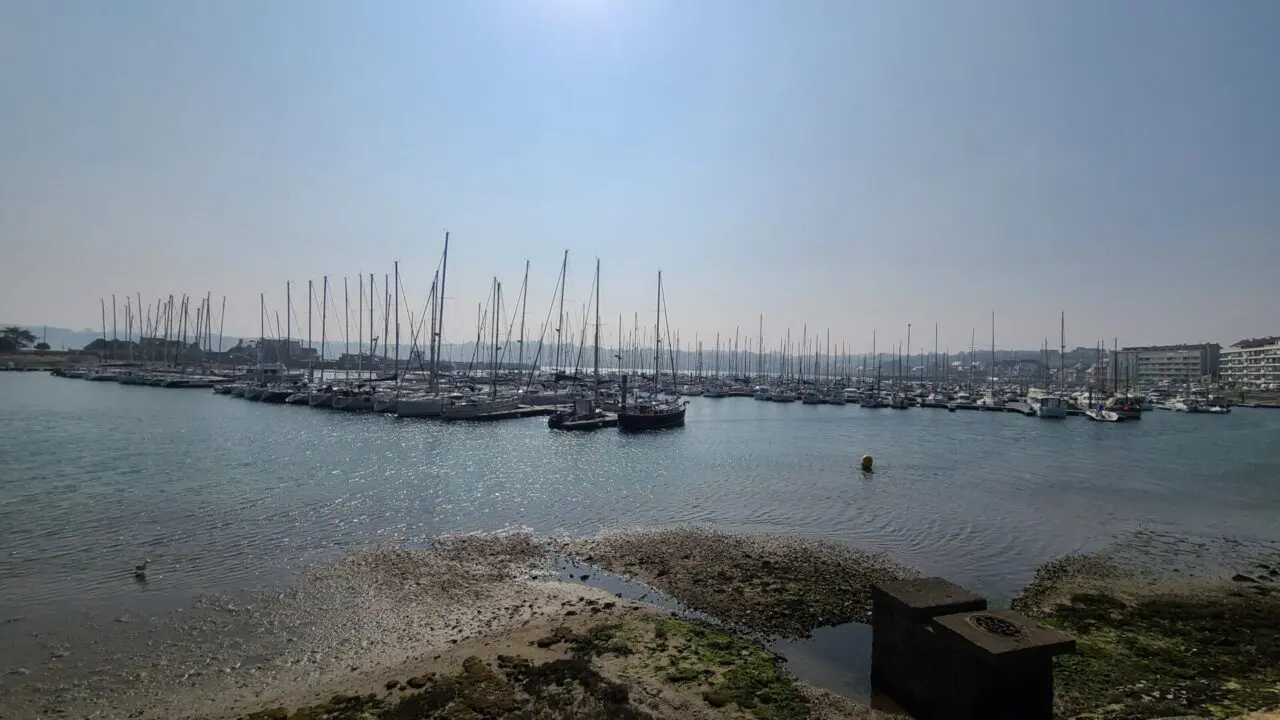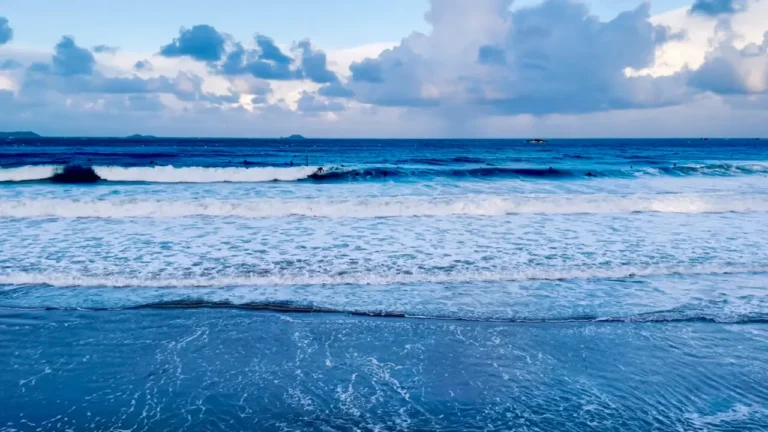Perros-Guirec – like Lannion that I wrote about in my previous post, I wonder if there’s even a single Korean who knows about this place. Still, it’s quite famous among the French as a resort destination. Let me start with the pronunciation, which isn’t exactly straightforward – Perros has two r’s, Guirec has one r, making it quite a tongue-twister for Koreans. It falls somewhere between “Peh-hos-Gee-hek” and “Peh-ros-Gee-rek” – I still can’t properly roll those French r’s. Anyway, I’ll stick with the anglicized “Perros-Guirec” throughout this post since you won’t hear me pronouncing it anyway.
This Perros-Guirec I’m introducing is also in Brittany (Bretagne), a region that feels like Korea’s Gangwon Province in terms of its rugged coastal character. It’s actually right above Lannion, just a 20-minute drive away. When I was first looking for a place to live around Lannion, I seriously considered finding a home in Perros-Guirec, with its elegant yachts floating right in front and hordes of surfers even in the dead of winter. Speaking of surfers, it reminds me of Yangyang – Perros-Guirec feels like France’s version of that Korean coastal resort town. The difference is that this place attracts mostly families, while Yangyang… well, let’s just say not all visitors there are purely focused on relaxation.
Anyway, let me introduce you to this small coastal town that stole my heart at first sight – my personal slice of seaside paradise that I’d drive to whenever I craved some ocean breeze.
1. Yachts I Wish I Could Own - The Marina Where I Don't Belong
The first requirement for any proper seaside resort town is a yacht marina. That’s my standard, at least. Any decent resort destination should attract wealthy folks looking to unwind, right? Rich people have the luxury of investing in toys like yachts. So a place with a yacht marina means it’s a famous resort that attracts the well-heeled. Logical, isn’t it?
Well, when you arrive at Perros-Guirec’s waterfront, the first thing that hits you is the yacht marina. Translation: this is where rich people come to play.
From the photo, it might look like Busan’s harbor, but this is definitely France. I mentioned earlier how it reminded me of Korea’s East Coast – the deep blue sea, powerful waves, and solid-looking rocky cliffs give it that East Sea vibe. Though the tidal range here is surprisingly large, which means lots of mudflats. I don’t recall ever seeing tidal flats on Korea’s East Coast though – am I wrong about that?
Getting closer, you start thinking, “Hmm, maybe I could afford one of these?” Some of them don’t look like much, right? That little boat on the right with “PL 58” something – surely I could save up enough pocket money for that?? But even the modest yachts here would cost at least as much as a small car. With that kind of money…
Looking at these weathered boats, thinking “owning one of these would just be a headache,” I wiped away a tear and turned to leave. The atmosphere was lovely, but my mood and bank account weren’t quite there.
2. Activities (Surfing, Kite Surfing, Dinghy Sailing, etc.)
What comes to mind when you think of Yangyang? Scantily clad, starving young men and women? No, that’s not right. Surfing should be the first thing that pops up. Yangyang is supposedly a surfing mecca. Perros-Guirec is also a surfing paradise, with people flocking here year-round to enjoy water activities – we’re talking dozens upon dozens.
The most famous Trestraou Beach feels like an all-weather seaside destination. Surrounded by accommodations, restaurants, and a bustling area, it’s perfect for family vacations. Right on the beach, people enjoy dinghy sailing and kite surfing, and on days with big waves, it’s crawling with surfers. There are always plenty of people walking along the sandy beach and the boardwalk above.
Parking is convenient and there are plenty of amenities – even though this photo was taken in the dead of winter, you can still see quite a few people around. Of course, winter isn’t peak season, so some restaurants are closed, and it does get pretty chilly.
But just like Yangyang attracts people addicted to that dopamine rush, regardless of whether it’s hot or cold, there are always people surrendering themselves to the waves here. Often more people in the water than on the beach itself.
The color of the sea looks quite different in these shots – one is a capture from a Galaxy phone video, the other from an iPhone video. Some editing was involved too. If you zoom into that dark blue sea photo, you’ll spot countless surfers in black wetsuits bobbing up and down in the waves. An almost ridiculous number of them. I wanted to be one of them.
If you could surf right in front of your house, wouldn’t anyone want to try? At least my girlfriend and I felt that way. But imagination and execution are entirely different realms. All the gear you’d need, the hassle of preparation before and after surfing, the overwhelming prospect of learning something new, plus the cost and time investment – the unglamorous reality hits hard. Beaten down by work, life, and sheer laziness, you eventually give up on the dream. I sometimes wonder what would have happened if I’d been a bit younger, or had more of a romantic streak, but that’s pointless regret over time already passed.
3. Perros-Guirec's Pride and Specialties
When you think of Busan’s pride and specialties, so many things come to mind it’s hard to list them all. Among these, food takes the biggest share. Perros-Guirec, being a fairly famous French resort town facing the Atlantic, is particularly renowned for its seafood.
First, there are oysters (Huîtres) that Europeans go crazy for. I’ll cover this in detail in my upcoming Cancale travel post, but Brittany is a famous oyster-producing region. They’re a different species from Korean oysters with a completely different taste – I’ll save the details for the Cancale piece.
Next, scallops. Breton scallops (Coquilles Saint-Jacques) are considered top-tier even in Europe. Despite being from a coastal area where they should be cheap, they’re quite expensive. Even at the supermarket they cost a fortune, so I barely got to try them.
Then there’s lobster (Homard breton). Breton lobster supposedly has rich flavors and is beloved in fine dining. I can’t even remember if I’ve seen one in person, let alone tasted it.
Finally, mussels (Moules-frites). Brittany-style mussels cooked in cream or wine sauce are popular. You’ll find them on the menu at pretty much any restaurant around here. But from a Korean perspective – especially someone whose father’s hometown is on the East Coast – paying tens of thousands of won for mussels that wash up with the waves and barely count as seafood back home felt a bit much. Sure, they might be different species with different flavors, but still, it didn’t sit right with me. Though there’s no doubt French people go absolutely wild for these ingredients and dishes.
So what did I end up eating?
A flaming T-bone steak. I went for meat at Restaurant l’Ardoise, which has a slight ocean view. Seafood is great and all, but I guess I was craving meat that day. Or maybe nothing on the seafood menu appealed to me.
The T-bone steak comes out with dried herbs placed on the bone between the strip and tenderloin, set on fire. Pure performance. It wasn’t a place that grilled meat well though – the doneness was uneven. I ordered medium, but one side came out medium-rare while the other was embarrassingly undercooked, barely qualifying as blue rare. I didn’t have high expectations anyway, so I just ate it as it was.
My girlfriend ordered the scallop dish. As I mentioned, Breton scallops are supposedly exceptional quality. Great plating, excellent sauce, vegetables looked a bit shabby, but the scallops were cooked to perfection. Tasted good too. The portion… not so much.
Dining out in France, you often encounter plates with thoughtful presentation. Maybe it’s because it’s the country of art, but even less famous restaurants put considerable effort into their presentation. Still, there are occasional disasters. I’m partly to blame for not having the budget for Michelin-level establishments, but the plating above seems pretty decent by my standards.
4. Côte de Granit Rose (Pink Granite Coast) and the GR34 Hiking Mecca
A post-meal walk is the golden rule. While the beaches I mentioned in section 2 – Trestraou Beach, Plage de Trestregnel, Plage de Saint-Guirec, Plage de Porz Balan – are all great for walking, Perros-Guirec has a signature walking route that stands out.
As I briefly mentioned in my Lannion post, many Brittany houses are built using granite. Among these granites, there are the typical dark, somber stones we usually think of, but also smooth stones with a pinkish hue. The place to see these stones is the Côte de Granit Rose (Pink Granite Coast). Technically, all the beaches I mentioned above are part of this Pink Granite Coast, but it’s not easy to spot the pink granite there.
You need to go to the Phare de Men Ruz (Men Ruz Lighthouse) area to properly witness the pink granite with your own eyes. The lighthouse in the photo above is only visible to good people, so open your eyes wide and look carefully.
During sunrise or sunset, the pink granite including the lighthouse burns intensely, creating a stunning contrast with the sea, but the day I took this photo was overcast and the timing was off, so the colors are a bit muted. The most beautiful scenery is best stored in your memory rather than photos, so if you’re curious, I recommend visiting in person.
So where is this hiking mecca GR34? Everything we’ve seen so far is within GR34. What does that mean?
In French it’s Bretagne, in English it’s Brittany, – search any of these on a map and you’ll find a region covering all of northwestern France. Like the Korean peninsula, it’s a region surrounded by sea on three sides. All the coastline where this Brittany region meets the sea – about 2,000km in total – is called GR34 (Grande Randonnée 34, The Customs Path), or the Brittany Coastal Path. In the 18th century, customs officers used it to watch for smugglers, hence the name Customs Path or Sentier des Douaniers.
This path is not only France’s most famous long-distance hiking route but also one of the world’s most beautiful walking trails. Completing this circuit means you’ve conquered Brittany. Starting from Mont-Saint-Michel that I posted about, passing through Saint-Malo, hitting this Perros-Guirec, going through the westernmost port city of Brest, and reaching the Quiberon Peninsula (Presqu’île de Quiberon) facing the Atlantic – that’s the full course.
Since I don’t enjoy walking and just drove around to various places, I never completed it. I’ll leave that achievement for you. This is for you.
Anyway, since all the beaches and Men Ruz lighthouse mentioned above are included in this GR34, a proper post-meal walk should provide adequate digestion and diet benefits.
5. Exploring Downtown Perros-Guirec
While Perros-Guirec is primarily a romantic seaside resort town, downtown has its own attractions. Namely, Brittany’s characteristic humble churches and bakeries.
Let’s start with église Saint-Jacques church.
This church also uses pink granite. Compared to the ornate cathedrals found throughout Europe, it might seem modest, but it has a simple charm. The granite pieces fitted together like Tetris create a mosaic-like effect. Truly the country of art.
Sometimes on weekends you’ll spot couples having their wedding ceremony, and the interior is supposedly quite grand. Apparently filled with European-style stained glass and intricate carvings. I never thought to go inside – looking back, I regret not exploring it. Since photos are all that remain from travels, make sure to take plenty.
The real destination wasn’t the church but the bakery. The main mission was finding Galette des Rois before the season ended and it became hard to find. Now sold in quite a few places in Korea so bread enthusiasts might know it, but traditionally it’s bread eaten on January 6th for Epiphany. Galette des Rois literally means “King’s Cake.”
Made in millefeuille style with layers of flaky pastry, stuffed with almond cream called frangipane. This almond cream is the sole reason to eat this bread. I tried it once or twice in Korea but it never tasted like the original. If you happen to be reading this in early January, I highly recommend trying one. It’s genuinely delicious.
I successfully purchased a Galette des Rois from Ty Coz Boulangerie Pâtisserie in downtown Perros-Guirec, where they had a few remaining. You can see a paper crown on the wrapping – inside that big pie is a small ceramic figurine called a fève. Whoever gets the piece with the figurine becomes king and gets to wear the crown.
Galette des Rois is traditional in northern France and Paris, while Brioche des Rois (brioche bread with sugar crystals and fruit decorations) is eaten in southern France. I haven’t been to the south yet so I don’t know what it looks like. I’m not sure if it’s sold in Korea either, probably because I’m not interested enough to notice.
But I do know this: that bread we’re all familiar with, the one even Paris Baguette (a popular Korean bakery chain) sells – Kouign-Amann – that’s Brittany’s signature bread.
I didn’t buy any because I didn’t have a measly 13.9 euros. Bread prices are brutal in this town – that’s Perros-Guirec for you.
6. In Closing
While the East Sea in front of my father’s hometown is the beach I’ve visited most in my life, outside of Korea, the sea I’ve visited most is undoubtedly the waters off Perros-Guirec. The vast ocean where I dreamed countless dreams – like surfing. In reality, all I managed to do was collect shells and take walks, but it’s undoubtedly a place that will remain treasured in my memory.
Every adult should have their own personal stretch of coastline. I’ve saved Perros-Guirec as my personal sea. Hoping that someday I’ll have the wealth to casually buy a yacht, this worker ant continues buying lottery tickets today. For the day I can become a grasshopper.













